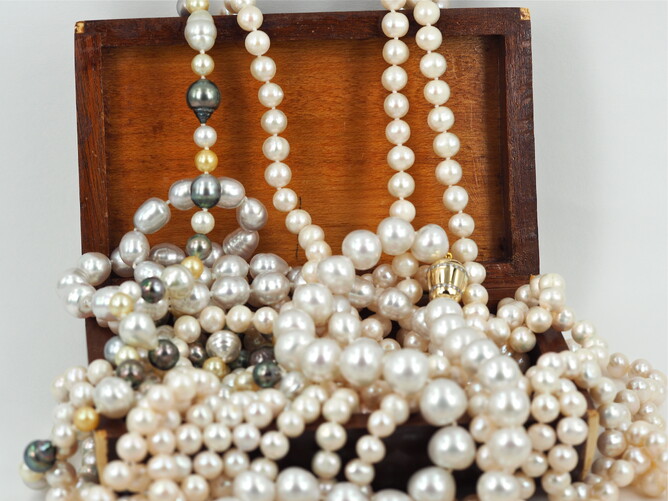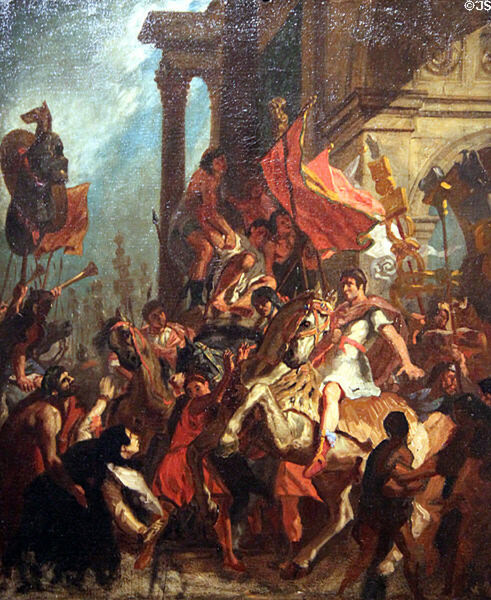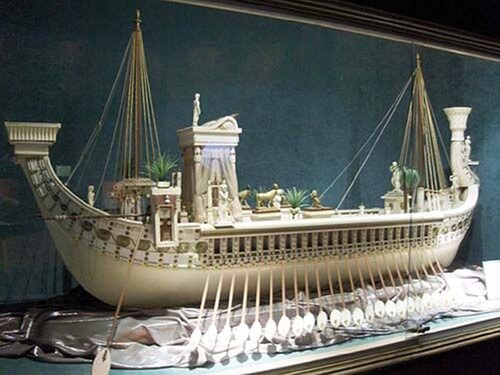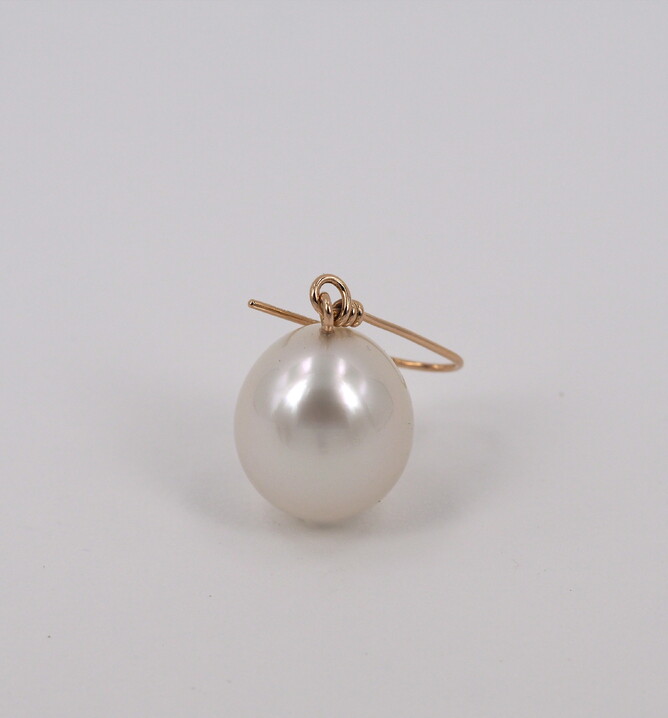The Romans and Pearls
"Friends, Romans, countrymen, lend me your ears."
'I hereby decree pearls to be Rome's most precious commodity!'
'I hereby decree pearls to be Rome's most precious commodity!'
Perhaps not spoken quite like that, but in late B.C, early A.D, pearls were ranked as Rome's most precious commodity.
Pearls were so valuable that an entire military campaign could be financed by the sale of a single pearl.
Rome's surrounding seas did not have pearl- bearing molluscs so how did they come by them?
Pearls were so valuable that an entire military campaign could be financed by the sale of a single pearl.
Rome's surrounding seas did not have pearl- bearing molluscs so how did they come by them?
Pearl Bounty
In order to get a better picture, we will begin 4th Century B.C at the time of Alexander the Great's rule.
Alexander conquered the lands from Greece and Egypt in the west to India in the East.
The bounty from some of his military expeditions was, of course, pearls.
When he returned with these glowing gems, it was the first time they had been brought to light for the Greeks and Egyptians.
The Greeks were not as interested in adorning themselves with pearls as the Alexandrians in Egypt were.
Instead, they kept them in the Greek treasuries, with some being used to adorn statues of gods and goddesses – in particular, Aphrodite.
After the death of Alexander the Great in 323B.C, the Greeks started to lose their stronghold on foreign lands.
Alexander conquered the lands from Greece and Egypt in the west to India in the East.
The bounty from some of his military expeditions was, of course, pearls.
When he returned with these glowing gems, it was the first time they had been brought to light for the Greeks and Egyptians.
The Greeks were not as interested in adorning themselves with pearls as the Alexandrians in Egypt were.
Instead, they kept them in the Greek treasuries, with some being used to adorn statues of gods and goddesses – in particular, Aphrodite.
After the death of Alexander the Great in 323B.C, the Greeks started to lose their stronghold on foreign lands.
Here come the Romans!
So time now for the Romans to move in.
They plundered the Greek treasuries and took possession of their beautiful pearls.
They plundered the Greek treasuries and took possession of their beautiful pearls.
Egypt also succumbed to the power of the Romans along with her supply of pearls.
Pearls, as I mentioned before, were Rome's most precious commodity.
They were an important part of the empire's economic and political structure.
They were prized and desired by all and the empire's aristocracy developed ' a veracious appetite' for them.
Of course, they couldn't have just anybody wearing them, so Julius Caesar enacted sumptuary laws to ensure ' pearls were only worn by women above a certain rank.'
It was said that ' a pearl worn by a woman in public was as good as a lictor walking before her.'
Hard to find a good lictor these days!
Pearls, as I mentioned before, were Rome's most precious commodity.
They were an important part of the empire's economic and political structure.
They were prized and desired by all and the empire's aristocracy developed ' a veracious appetite' for them.
Of course, they couldn't have just anybody wearing them, so Julius Caesar enacted sumptuary laws to ensure ' pearls were only worn by women above a certain rank.'
It was said that ' a pearl worn by a woman in public was as good as a lictor walking before her.'
Hard to find a good lictor these days!
Empress Needing to Impress
One such woman was Emperor Caligula's wife in approx. 37 A.D.
Wanting to impress upon people her wealth, she arrived at a festival adorned from head to foot in pearls and emeralds.
In order to make sure that no one underestimated the value of her attire, she carried papers to attest its worth.
It is believed her costumes 'worth' was near 40 million sesterces or 1 ¼ million ounces of silver!
Wanting to impress upon people her wealth, she arrived at a festival adorned from head to foot in pearls and emeralds.
In order to make sure that no one underestimated the value of her attire, she carried papers to attest its worth.
It is believed her costumes 'worth' was near 40 million sesterces or 1 ¼ million ounces of silver!
Gold versus Pearls
The power of the Roman Empire lasted for a considerable length of time. At some point though, political and economic mistakes were made and large 'chinks' started to appear in their armour. Thus leading to their downfall.
One such mistake was believed to be the imbalance of pearls versus gold in their treasuries.
One such mistake was believed to be the imbalance of pearls versus gold in their treasuries.
Side Story
Mark Antony and Cleopatra and a magnificent pearl.
Cleopatra
In order to give a better picture of the story I am about to tell, I will digress and tell you a little about Cleopatra.
Factual history about her is a little sketchy and most of the information comes from Greco-Roman scholars, in particular Plutarch.
Cleopatra was born 69 B.C and believed to be the daughter of a Greek general Ptolemy and his Egyptian half sister, her mother.
Groomed from a young age to one day rule, she was versed in several languages, educated in maths, philosophy, oratory and had extensive knowledge of perfumes and poisons.
At 18yrs of age she ruled Egypt with her 10yr old brother Ptolemy XIII.
Ptolemy XIII's advisors caused Cleopatra to flee Egypt.
At this time Julius Caesar arrived on Egypt's shores in search of his enemy Pompey, who was hiding in Alexandria.
Ptolemy XIII saw to Pompey's end and then met with Julius Caesar in order to seek his allegiance over his sister.
After their meeting, Ptolemy felt confident that he had Caesar's backing and that his sister was nowhere in sight.
Not so – Cleopatra found a way into Caesar's chambers to plead her case. Using her charm and intellect, Cleopatra managed to change Caesar's mind and secure allegiance for herself.
The arrival of Caesar's reinforcements saw Ptolemy XIII dispatched and Cleopatra reinstated to the throne with her younger brother, Ptolemy XIV.
(One could believe there was a short supply of names back then!)
Caesar stayed in Egypt for some time and Cleopatra gave birth to a son called – yes, you guessed it, Ptolemy Caesar. He was believed to be Caesar's son and nicknamed 'little Caesar' by the people of Egypt.
Julius Caesar returned to Rome and in 44 B.C, he was murdered.
Factual history about her is a little sketchy and most of the information comes from Greco-Roman scholars, in particular Plutarch.
Cleopatra was born 69 B.C and believed to be the daughter of a Greek general Ptolemy and his Egyptian half sister, her mother.
Groomed from a young age to one day rule, she was versed in several languages, educated in maths, philosophy, oratory and had extensive knowledge of perfumes and poisons.
At 18yrs of age she ruled Egypt with her 10yr old brother Ptolemy XIII.
Ptolemy XIII's advisors caused Cleopatra to flee Egypt.
At this time Julius Caesar arrived on Egypt's shores in search of his enemy Pompey, who was hiding in Alexandria.
Ptolemy XIII saw to Pompey's end and then met with Julius Caesar in order to seek his allegiance over his sister.
After their meeting, Ptolemy felt confident that he had Caesar's backing and that his sister was nowhere in sight.
Not so – Cleopatra found a way into Caesar's chambers to plead her case. Using her charm and intellect, Cleopatra managed to change Caesar's mind and secure allegiance for herself.
The arrival of Caesar's reinforcements saw Ptolemy XIII dispatched and Cleopatra reinstated to the throne with her younger brother, Ptolemy XIV.
(One could believe there was a short supply of names back then!)
Caesar stayed in Egypt for some time and Cleopatra gave birth to a son called – yes, you guessed it, Ptolemy Caesar. He was believed to be Caesar's son and nicknamed 'little Caesar' by the people of Egypt.
Julius Caesar returned to Rome and in 44 B.C, he was murdered.
Enter Stage Right – Mark Antony
After the death of Julius Caesar, Mark Antony and Octavian fought against Caesar's assassins, Brutus and Cassius.
Both sides requested reinforcements from Cleopatra.
After some deliberation Cleopatra sent Roman legions, stationed in Egypt, to aid Mark Antony in his plight.
Both sides requested reinforcements from Cleopatra.
After some deliberation Cleopatra sent Roman legions, stationed in Egypt, to aid Mark Antony in his plight.
And now our story heats up!
After defeating his enemies, Mark Antony summoned Cleopatra to Tarsus to seek her support in further military campaigns.
Indignant at being summoned, she delayed her arrival at Tarsus. When she could delay no longer, she sailed into the city of Tarsus on a lavish barge.
Indignant at being summoned, she delayed her arrival at Tarsus. When she could delay no longer, she sailed into the city of Tarsus on a lavish barge.
Infatuation
General Mark Antony was a man known to favour women and his first encounter with Cleopatra left him completely infatuated with her.
Quote from Plutarch (Mark Antony was)
.."carried away by her to Alexandria, there to keep holiday, like a boy, in play and diversion, squandering and fooling away in enjoyment that most costly of all valuables, time."
Mark Antony and Cleopatra's courtship saw them having many lavish and extravagant dinners together.
At one such dinner, Cleopatra wagered with Mark Antony that she could consume a meal worth more than an entire city.
Interest piqued and struggling to resist this gorgeous woman, Mark Antony agreed to the wager.
As the evening proceeded and the dinner appeared to be like any other, Mark Antony was yet to see how the meal could be worth more than an entire city.
And then Cleopatra, with an undoubtedly mischievous grin and provocative manner, proceeded to remove one of her large pearl earings.
Quote from Plutarch (Mark Antony was)
.."carried away by her to Alexandria, there to keep holiday, like a boy, in play and diversion, squandering and fooling away in enjoyment that most costly of all valuables, time."
Mark Antony and Cleopatra's courtship saw them having many lavish and extravagant dinners together.
At one such dinner, Cleopatra wagered with Mark Antony that she could consume a meal worth more than an entire city.
Interest piqued and struggling to resist this gorgeous woman, Mark Antony agreed to the wager.
As the evening proceeded and the dinner appeared to be like any other, Mark Antony was yet to see how the meal could be worth more than an entire city.
And then Cleopatra, with an undoubtedly mischievous grin and provocative manner, proceeded to remove one of her large pearl earings.
She crushed the pearl in a bowl and tipped the powder into her wine and drank it.
Interruption…..
Exactly how Cleopatra consumed the pearl is a little debated. Some stories suggest that she merely dropped the pearl into her wine, saw it dissolve and drank it.
Even though, back then, the wine would have been more like vinegar than the wine of today, it would have taken a few days to dissolve.
She could also have just swallowed the pearl but considering its size, she probably would have choked.
I have contemplated placing a small keshi pearl in wine and one in vinegar in order to see what would happen, but I couldn't bear the waste!
On the thought of waste, I do wonder what Mark Antony's reaction would have been.
Most likely disbelief, awe, a grin and then an overwhelming desire for her!
Interruption…..
Exactly how Cleopatra consumed the pearl is a little debated. Some stories suggest that she merely dropped the pearl into her wine, saw it dissolve and drank it.
Even though, back then, the wine would have been more like vinegar than the wine of today, it would have taken a few days to dissolve.
She could also have just swallowed the pearl but considering its size, she probably would have choked.
I have contemplated placing a small keshi pearl in wine and one in vinegar in order to see what would happen, but I couldn't bear the waste!
On the thought of waste, I do wonder what Mark Antony's reaction would have been.
Most likely disbelief, awe, a grin and then an overwhelming desire for her!
Did this legend actually occur?
According to our good fellow Pliny the Elder, it did and the pearl was worth approx. one million ounces of silver.
What of the remaining pearl?
Some time later, after Cleopatra's death, the pearl was sliced in half (argh!) and placed on the ears of an Aphrodite statue.
What of the remaining pearl?
Some time later, after Cleopatra's death, the pearl was sliced in half (argh!) and placed on the ears of an Aphrodite statue.
Fall of the Empire
By the 5th century A.D, the might and power of the Roman Empire had fallen and with it one of history's biggest pearl crazes.
Pearls were not lost or forgotten and in the era that followed, the Byzantines crafted some of the finest pearl jewellery ever seen.
The time of the Roman Empire is an extraordinary and fascinating part of history and my blog is sadly, the merest of glimpses into it.
Next time....
For Part 4 of Pearls, Power and Wars, I will look briefly into China's history with pearls.
Reference
Pearls – Ornament and Obsession
By Kristin Joyce and Shellei Addison
By Kristin Joyce and Shellei Addison





